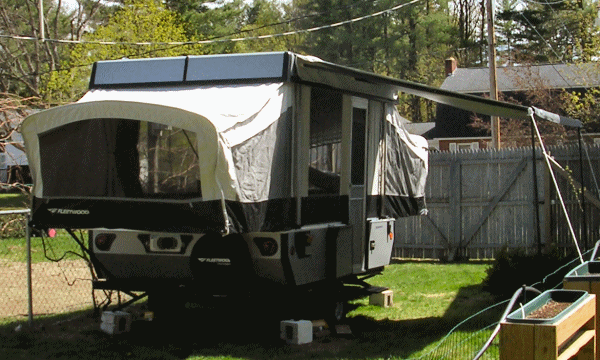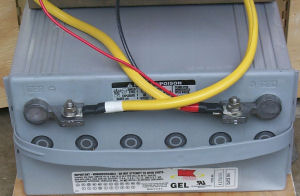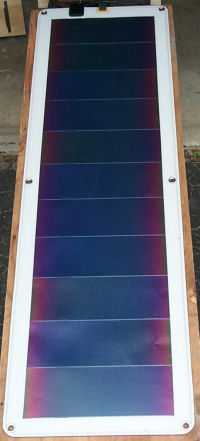
ARES/RACES |
Antennas |
Public Service Events |
But can you move it if you had to?
All my gear is purchased and installed with the idea that I may have to relocate it to support the ARES/RACES
I recently invested in a pop-up camper (we decided we were getting too old for sleeping on the ground as we have spent MANY nights there when younger), and it seems perfect for some sort of renewable power system.
It is a Graphite model, manufactured by Fleetwood.
It has a deep cycle marine battery on the tongue, and a cord for shore power. They both meet under one of the bench seats in a power center. The existing system will take AC and run its DC appliances (2 ceiling lights, 1 outdoor light, heater controls and combustable gasses monitor, but on DC only, the AC outlets will not work. The unit is therefore a converter (AC to DC), not an inverter (DC to AC).
Some of my thoughts / goals for the project:
1) replace or supplement the existing battery
2) install an inverter for AC (we have never been to a location where there was shore power available)
3) install a charge controller for the batteries, that will take PV solar power and safely charge the batteries, and have a low voltage disconnect
4) install a PV panel for charging the batteries
5) install DC circuits for LED lighting, Ham radios, cd player, or other 12VDC accessories
Power Needs
What do we plan to run while in the camper, and for how long?
Lights, small stereo, 2-way radios, recharging ability for other electronics (cell phone, camera), ham radio.
12 VDC vs 120 VAC
Well, most of the time we camp, we do not have shore power available, so DC is going to be our primary power source. However there will be times when an item will only run on AC, such as my cell phone recharger, and AA recharger. I could acquire DC chargers for some of these items, but I am planning to install an inverter, so even though it decreases efficiency even more, I won't have to buy anything more.
So, the question is, how can I backfeed the existing AC outlets in the trailer from the to be added inverter in the safest and easiest fashion?
Calculating power needs...
Watts:
The poor watt is often misunderstood. Watts are basically just a measure of how much power a device uses when turned on, or can supply. A watt is a watt - there is no such thing as "watts per hour", or "watts per day". If a something uses 100 watts, that is simply the voltage times the amps. If it pulls 10 amps at 12 volts, or 1 amp at 120 volts, it is still 120 watts. A watt is defined as a bunch of Joules per second, so saying watts per hour is like saying "miles per hour per day".
Energy:
Power used over Time, measured in Watt Hours (Wh) or Amp hours (Ah).
A watt-hour (or kilowatt hour, kWh) is simply how many watts times how many hours that is used for. This is what most people mean when they say "watts per day". If a light uses 100 watts, and it is on for 9 hours, that is 900 watt-hours. If a microwave uses 1500 watts, and runs for 10 minutes, that is 1/6th of an hour x 1500, or 250 WH. When you buy power from your friendly utility (look at your last bill), they sell it to you at so much per KWH. A kwh is a "kilowatt hour", or 1000 watts for one hour (or 1 watt for 1000 hours).
Amp-hours (usually abbreviated as Ah) are what most people mean when they say "amps per hour" etc. Amps x time = AH. AH are very important, as it is the main measure of battery capacity. Since most inverters run from batteries, the AH capacity determines how long you can run.
Amps: Volts
People often get confused about the correct units in which to measure power consumption. Watts measure power being used or created at any given instant. But Energy is what's most important to you, not power-- Energy is power measured over time. It doesn't matter that the big TV in your camper uses 200 watts. The real issue is how many hours per day you have the thing on! So, the proper units to use are watt-hours or amp-hours (A/H), not watts or amps. Ten amp-hours of use means that you ran your boom box that draws one amp for 10 hours--or that you ran your big TV that draws 10 amps for one hour. You get the idea.
Appliances and lights are usually rated in watts, and they are usually marked on the back for how many watts they draw at full power. Batteries are rated in amp-hours of capacity. The only math you need to do for designing a simple RE system is converting watts to amps. Then you multiply by time to get amp-hours. Watts = amps x volts, and amps = watts / volts. So, a 60 watt light bulb powered from your inverter will use 1/2 amp at 120 volts AC (60 watts / 120 volts = 0.5 amps). But your battery is 12 volts! So to power this bulb, you need to do the math for what's really coming out of your 12 volt battery-- 60 watts / 12 volts = 5 amps.
An amp is a measure of electrical CURRENT at the moment. (Amps do not come in "amps per hour" or "amps per day" either). Amps are important because it determines what wire size you need, especially on the DC (low voltage) side of an inverter. All wire has resistance, and amps flowing through a wire makes heat. If your wire is too small for the amps, you get hot wires. You can also get voltage drops in the wire if it is too small. This is not usually a good thing. (An amp is defined as so many electrons per second).
Battery
Technologies available:
Flooded / AGM / Gel
What I have available:
The trailer came with a marine deep cycle battery. For many reasons this is not my first choice in technology, although it is cheap - which is why the dealer used it.
I have 4, 12 VDC, 100 Ah AGM batteries removed from float service. These are true deep cycle batteries, with large lead plates for repeated deep discharging. Of course all that metal is heavy, and the batteries are physically large, so these may not be my first choice either. I'm actually leaning towards using these in my home...
I also have 2, 85 Ah Gel batteries that are in my Portable power system. 
One of these would be perfect, except it would mean I's have to disassemble my portable power system.
All in all, I think I'll use the existing marine battery, after all it is paid for, still has to run the electric trailer brakes, and is recharged by either shore power when connected, or the towing vehicle.
I think I'll design an independent power system for the trailer toys... When I'm ready, I'll buy an AGM battery to run it.
Sizing or how long can I get from a charge?
You never want to draw a battery below 50%. Better still for longevity if you keep your discharges below 30%.
Wiring
DC wiring
PV module to CCMy USI module came with a standard trailer power connector (2 pole). As it only produces 2.9A at max output, its conductor size is rather small. I have successfully used UL listed AC extension cords for low voltage (12 VDC), low current applications. They are reasonable in price, can carry an outdoor rating, and are readily available at your local hardware store.
CC to Battery
Battery to Inverter
Getting from the battery to the AC inverter, you want big wire, for minimum voltage drop. While not UL approved, I have found that automotive jumper cables are a good source of heavy cabling.
AC wiring
Existing AC wiring is made with standard household Romex.
Any that I add
Charge Control
The real question is, is this necessary for a system of this size?
If I go with a gel or AGM battery, this is a necessity, as overcharging will destroy these types of batteries (they have limited ability to vent the gasses produced when charging).
If I use a flooded lead acid battery, a CC is probably not needed. As this type of battery is charged (to the point of outgassing), the liquid is boiled away and evaporates. Bad for the battery, but with proper maintenance (refill with distilled water), no big deal.
What I have:
A Morningstar ProStar30A controller with LVD.
PV or Solar module
Some options in technology.
Normal panels are made using either single crystal or multi crystalline technology. This is the first and second highest efficiency option, however they are typically covered with glass, and this makes them less than ideal for this application.
Thin film or amorphous technology, while having less efficiency, has better survivability in this application.
Sizing and cost
What I have:
a flexible USI 32 W thin film panel.

Folding solar panels:
85W Photowatt panels
Over Current Protection & Power Distribution
To be safe, all systems need some type of OCP. Batteries can be huge
Fuses and circuit breakers are designed to protect the wires that are connected to them.
Inverter Choices
Pure Sine Wave
Pure sine wave is what most closely matches that which is provided by your utility company, however it is also the most complicated to make, and therefore the most costly. Any appliance that you can plug into your wall at home can be run on this technology, within the power limits of the inverter itself. A sine wave is what you get from your local utility company and (usually) from a generator. This is because it is generated by rotating AC machinery and sine waves are a natural product of rotating AC machinery.
- The major advantage of a sine wave inverter is that all of the equipment which is sold on the market is designed for a sine wave. This guarantees that the equipment will work to its full specifications.
- Some appliances, such as motors and microwave ovens will only produce full output with sine wave power.
- A few appliances, such as bread makers, light dimmers, and some battery chargers require a sine wave to work at all.
- Sine wave inverters are always more expensive - from 2 to 3 times as much
Modified sine wave (
A modified sine wave inverter actually has a waveform more like a square wave, but with an extra step or so. A modified sine wave inverter will work fine with most equipment, although the efficiency or power will be reduced with some.
- Motors, such as refrigerator motor, pumps, fans etc will use more power from the inverter due to lower efficiency. Most motors will use about 20% more power. This is because a fair percentage of a modified sine wave is higher frequencies - that is, not 60 Hz - so the motors cannot use it.
- Some fluorescent lights will not operate quite as bright, and some may buzz or make annoying humming noises.
- Appliances with electronic timers and/or digital clocks will often not operate correctly. Many appliances get their timing from the line power - basically, they take the 60 Hz (cycles per second) and divide it down to 1 per second or whatever is needed. Because the modified sine wave is noisier and rougher than a pure sine wave, clocks and timers may run faster or not work at all. They also have some parts of the wave that are not 60 Hz, which can make clocks run fast.
- Items such as bread makers and light dimmers may not work at all - in many cases appliances that use electronic temperature controls will not control. The most common is on such things as variable speed drills will only have two speeds - on and off.
Square wave
Very few but the very cheapest inverters any more are square wave. A square wave inverter will run simple things like tools with universal motors with no problem - but not much else. These are seldom seen any more except in the very cheap or very old ones.
What I have available
1 kW Pure sine wave
ProSine 1000, currently in my portable power system.
600 W MSW
PortaWattz
150 W and 75 W cigarette lighter plug-ins
xPower by Xantrex
All in one solution
xPower 1500 by Xantrex. This unit is like a small toolbox on wheels. It has an internal battery, an internal MSW inverter good to 1500 W, direct connect DC posts and a cigarette lighter output for accessories. The biggest drawback is its weight and that I am currently using it to power my rig in my automobile.
AC connection
How to connect the inverter to the existing AC outlets in the trailer, or simply use the direct outlets on the inverter?
If I want to be able to switch between shore power and the inverter powering the onboard outlets, I'd need something like a transfer switch. This would retain all the UL overcurrent protection as designed.
If I am lazy, I could turn off the main breaker on the trailer, and backfeed AC through one of the existing outlets (not recommended, but cheap and effective).